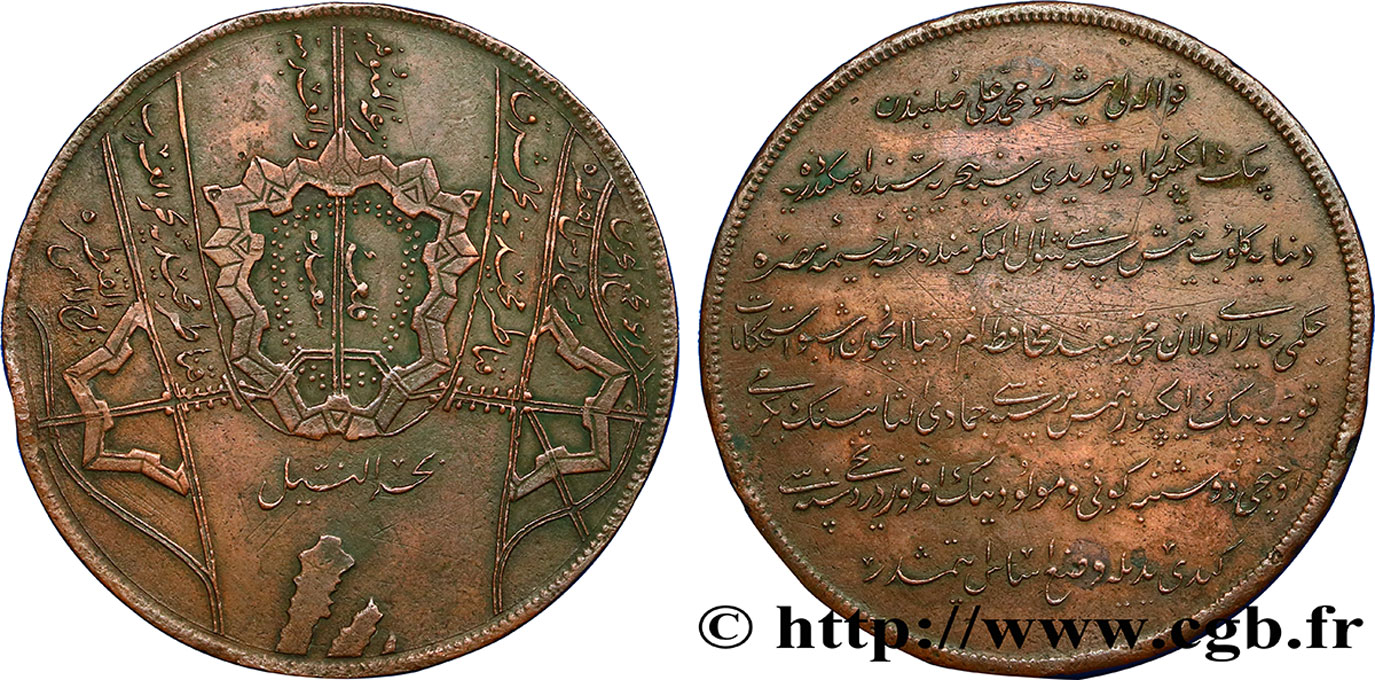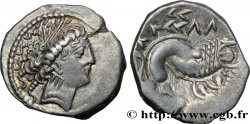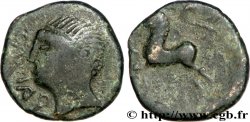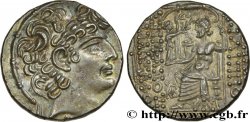Live auction - fme_401215 - ÉGYPTE - ROYAUME D'ÉGYPTE - ABDUL MEJID Médaille pour Abdul-Medjid et Saïd Pacha
Чтобы принять участие в торгах, вы должны войти в систему и стать подтвержденным участником аукциона. Войдите, чтобы сделать ставку. Ваш аккаунт будет подтвержден в течение 48 часов. Не ждите до закрытия торгов, чтобы зарегистрироваться.Сделав ставку на данный товар, вы вступаете в юридическое соглашение на покупку выбранного товара и нажатием кнопки «Сделать ставку» подтверждаете принятие вами условий интернет-аукционов cgb.fr.
Ставка может бить сделана только в полном эквиваленте евро. Торги закроются согласно времени, указанному в описании товара, все ставки, сделанные после закрытия торгов, учитываться не будут. Не следует откладывать предложение вашей ставки до последнего момента, так как система может не успеть обработать вашу заявку, и ваша ставка не будет принята. Более детальную информацию вы найдёте здесь: FAQ по интернет-аукционам.
Все ставки победителей подлежат комиссии 18%.
Все ставки победителей подлежат комиссии 18%.
| Оценить : | 900 € |
| Цена : | Нет ставки |
| Максимальная предлагаемая цена : | Нет ставки |
| Конец торгов : | 31 October 2017 17:32:34 |
Тип Médaille pour Abdul-Medjid et Saïd Pacha
Дата: 1855
Монетный двор / Город: Égypte, Turquie
Металл: bronze
Диаметр: 63 mm
Ориентация осей монеты: 12 h.
Вес: 91 g.
Век: lisse
Редкость: R2
Комментарии о состоянии
Intéressante médaille avec de beaux reliefs. Patine brune avec une usure homogène et quelques coups sur la tranche
Лицевая сторона
Аверс: легенда: LÉGENDE ARABE.
Аверс: описание: Plan de fortification sur le Nil ; carte géographique avec légendes en arabe.
Обратная сторона
Реверс: легенда: LÉGENDE ARABE.
Реверс: Описание: Légende en 7 lignes hrizontales.
Комментарий
Un exemplaire de cette rare médaille a été vendu 820$ en 2008 par Gorny & Mosch et un autre à 884$ en 2009 par Meister & Sonntag. En argent, bien que très usé, un exemplaire a été vendu 1900€ par H. D. Rauch en 2012 et revendu par Palombo 2700 francs suisses. Et plus récemment en 2017, Kunker a vendu un exemplaire à 3000€ (Auction 289, n° 2056).
Pour cette médaille, voir l’article "The Barrage Fortress Medal 1855 of Egyptian Vice-Roy Muhamad Sa'id Pasha" par K. M. MacKenzie dans le Bulletin 39/40 de la Société numismatique turque, Istanbul 2003, S. 97-99.
Abdülmecid Ier (Abdul-Medjid) fils ainé de Mahmoud II succède à l'âge de seize ans à son père, au moment où Ibrahim Pacha marchait sur Istanbul, et ne dut qu'à l'intervention européenne le maintien de l'intégrité de son empire (traités du 15 juillet 1840 et du 13 juillet 1841). Il poursuit, mais sans violence, les réformes commencées par son père et accorde à tous ses sujets, sans distinction de religion, par le hatti-chérif de Gulhané (3 novembre 1839) et le hatti-houmaioum du 11 février 1856, des garanties pour leur vie, leur fortune et leur liberté, et crée le conseil du tanzimat, chargé d'appliquer et d'étendre ces réformes.
Il fait réprimer de nombreuses insurrections, notamment celle de Bedirxan Beg au Kurdistan (1841-1847) ; il refuse en 1853 de céder au prince Menchikov au sujet de la protection par la Russie des lieux saints et des sujets grecs de l'empire ottoman, et soutient, avec l'appui de la France et de l'Angleterre, la Guerre de Crimée contre la Russie, qui se termine par le traité de Paris (1856).
Saïd Pacha (1822 - 1863) est le gouverneur (al-wālī) d’Égypte et du Soudan de 1854 à 1863. Il est le quatrième fils de Méhémet Ali. Muhammad Saïd, instruit à Paris, est francophone. Il succède à Abbas Ier après la mort de celui-ci en 1854 et hérite du titre de pacha que s'était octroyé son père.
Durant la Guerre civile américaine, qui entraine une pénurie de coton, l’Égypte devient le principal fournisseur des industries textiles européennes.
À la demande de Napoléon III en 1863, un bataillon de soldats soudanais part se battre au Mexique contre la rébellion des indépendantistes mexicains.
Sous le règne de Saïd, l’influence des cheikhs diminue.
Saïd est également à l'origine de la création du Service de conservation des antiquités de l'Égypte en 1858 (en même temps que du musée de Boulaq, qui est un organe indissociable du Service). Il en confia la direction à Auguste Mariette..
A example of this rare medal was sold for $820 in 2008 by Gorny & Mosch and another for $884 in 2009 by Meister & Sonntag. In silver, although very worn, a example was sold for €1,900 by H. D. Rauch in 2012 and resold by Palombo for 2700 Swiss francs. And more recently in 2017, Kunker sold a example for €3,000 (Auction 289, no. 2056).
For this medal, see the article \\\"The Barrage Fortress Medal 1855 of Egyptian Vice-Roy Muhamad Sa'id Pasha\\\" by K. M. MacKenzie in Bulletin 39/40 of the Turkish Numismatic Society, Istanbul 2003, S. 97-99.
Abdülmecid I (Abdul-Medjid), eldest son of Mahmoud II, succeeded his father at the age of sixteen, at the time when Ibrahim Pasha was marching on Istanbul, and owed only to European intervention the maintenance of the integrity of his empire (treaties of July 15, 1840 and July 13, 1841). He continued, but without violence, the reforms started by his father and granted to all his subjects, without distinction of religion, by the hatti-sherif of Gulhané (November 3, 1839) and the hatti-houmaioum of February 11, 1856, guarantees for their life, their fortune and their freedom, and created the council of the tanzimat, responsible for applying and extending these reforms..
He suppressed numerous insurrections, notably that of Bedirxan Beg in Kurdistan (1841-1847); in 1853 he refused to give in to Prince Menshikov on the subject of Russian protection of holy places and Greek subjects of the Ottoman Empire, and supported, with the support of France and England, the Crimean War against Russia, which ended with the Treaty of Paris (1856)..
Said Pasha (1822 - 1863) was the governor (al-wālī) of Egypt and Sudan from 1854 to 1863. He is the fourth son of Mehemet Ali. Muhammad Said, educated in Paris, is French-speaking. He succeeded Abbas I after his death in 1854 and inherited the title of pasha that his father had given himself..
During the American Civil War, which led to a cotton shortage, Egypt became the main supplier to the European textile industries..
At the request of Napoleon III in 1863, a battalion of Sudanese soldiers left to fight in Mexico against the rebellion of Mexican independence fighters..
Under Said's reign, the influence of the sheikhs diminished..
Said was also responsible for the creation of the Egyptian Antiquities Conservation Service in 1858 (at the same time as the Boulaq Museum, which is an inseparable organ of the Service). He entrusted its management to Auguste Mariette.
Pour cette médaille, voir l’article "The Barrage Fortress Medal 1855 of Egyptian Vice-Roy Muhamad Sa'id Pasha" par K. M. MacKenzie dans le Bulletin 39/40 de la Société numismatique turque, Istanbul 2003, S. 97-99.
Abdülmecid Ier (Abdul-Medjid) fils ainé de Mahmoud II succède à l'âge de seize ans à son père, au moment où Ibrahim Pacha marchait sur Istanbul, et ne dut qu'à l'intervention européenne le maintien de l'intégrité de son empire (traités du 15 juillet 1840 et du 13 juillet 1841). Il poursuit, mais sans violence, les réformes commencées par son père et accorde à tous ses sujets, sans distinction de religion, par le hatti-chérif de Gulhané (3 novembre 1839) et le hatti-houmaioum du 11 février 1856, des garanties pour leur vie, leur fortune et leur liberté, et crée le conseil du tanzimat, chargé d'appliquer et d'étendre ces réformes.
Il fait réprimer de nombreuses insurrections, notamment celle de Bedirxan Beg au Kurdistan (1841-1847) ; il refuse en 1853 de céder au prince Menchikov au sujet de la protection par la Russie des lieux saints et des sujets grecs de l'empire ottoman, et soutient, avec l'appui de la France et de l'Angleterre, la Guerre de Crimée contre la Russie, qui se termine par le traité de Paris (1856).
Saïd Pacha (1822 - 1863) est le gouverneur (al-wālī) d’Égypte et du Soudan de 1854 à 1863. Il est le quatrième fils de Méhémet Ali. Muhammad Saïd, instruit à Paris, est francophone. Il succède à Abbas Ier après la mort de celui-ci en 1854 et hérite du titre de pacha que s'était octroyé son père.
Durant la Guerre civile américaine, qui entraine une pénurie de coton, l’Égypte devient le principal fournisseur des industries textiles européennes.
À la demande de Napoléon III en 1863, un bataillon de soldats soudanais part se battre au Mexique contre la rébellion des indépendantistes mexicains.
Sous le règne de Saïd, l’influence des cheikhs diminue.
Saïd est également à l'origine de la création du Service de conservation des antiquités de l'Égypte en 1858 (en même temps que du musée de Boulaq, qui est un organe indissociable du Service). Il en confia la direction à Auguste Mariette..
A example of this rare medal was sold for $820 in 2008 by Gorny & Mosch and another for $884 in 2009 by Meister & Sonntag. In silver, although very worn, a example was sold for €1,900 by H. D. Rauch in 2012 and resold by Palombo for 2700 Swiss francs. And more recently in 2017, Kunker sold a example for €3,000 (Auction 289, no. 2056).
For this medal, see the article \\\"The Barrage Fortress Medal 1855 of Egyptian Vice-Roy Muhamad Sa'id Pasha\\\" by K. M. MacKenzie in Bulletin 39/40 of the Turkish Numismatic Society, Istanbul 2003, S. 97-99.
Abdülmecid I (Abdul-Medjid), eldest son of Mahmoud II, succeeded his father at the age of sixteen, at the time when Ibrahim Pasha was marching on Istanbul, and owed only to European intervention the maintenance of the integrity of his empire (treaties of July 15, 1840 and July 13, 1841). He continued, but without violence, the reforms started by his father and granted to all his subjects, without distinction of religion, by the hatti-sherif of Gulhané (November 3, 1839) and the hatti-houmaioum of February 11, 1856, guarantees for their life, their fortune and their freedom, and created the council of the tanzimat, responsible for applying and extending these reforms..
He suppressed numerous insurrections, notably that of Bedirxan Beg in Kurdistan (1841-1847); in 1853 he refused to give in to Prince Menshikov on the subject of Russian protection of holy places and Greek subjects of the Ottoman Empire, and supported, with the support of France and England, the Crimean War against Russia, which ended with the Treaty of Paris (1856)..
Said Pasha (1822 - 1863) was the governor (al-wālī) of Egypt and Sudan from 1854 to 1863. He is the fourth son of Mehemet Ali. Muhammad Said, educated in Paris, is French-speaking. He succeeded Abbas I after his death in 1854 and inherited the title of pasha that his father had given himself..
During the American Civil War, which led to a cotton shortage, Egypt became the main supplier to the European textile industries..
At the request of Napoleon III in 1863, a battalion of Sudanese soldiers left to fight in Mexico against the rebellion of Mexican independence fighters..
Under Said's reign, the influence of the sheikhs diminished..
Said was also responsible for the creation of the Egyptian Antiquities Conservation Service in 1858 (at the same time as the Boulaq Museum, which is an inseparable organ of the Service). He entrusted its management to Auguste Mariette.








 Cообщить об ошибке
Cообщить об ошибке Распечатать страницу
Распечатать страницу Отправить мой выбор
Отправить мой выбор Задать вопрос
Задать вопрос Consign / sell
Consign / sell










